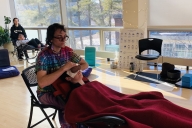You have /5 articles left.
Sign up for a free account or log in.

Seven percent of freshman Student Voice survey respondents say they’ve experienced telecounseling arranged through their institutions, as do 12 percent of sophomores.
Tashi-Delek/E+/Getty Images
Telecounseling for college students isn’t going anywhere. That’s one takeaway from a new report on critical considerations for partnering with teletherapy vendors from the American Council on Education, says co-author Nance Roy.
“The current landscape suggests that teletherapy is here to stay and can be a useful and effective offering for colleges to consider,” says Roy, chief clinical officer at the Jed Foundation and an assistant clinical professor of psychiatry at Yale University.
While traditional in-person, group and individual therapy remain “excellent treatment choices,” she adds, teletherapy can provide services and support to those “who may never access in-person counseling or are more comfortable with a digital option.” Offering a variety of treatment options can allow colleges and universities to reach “the largest share of students and best support their mental health.”
Virtual counseling by on-campus providers became commonplace during the pandemic, as did partnerships with third-party teletherapy vendors. But even as pandemic mitigation efforts have relaxed, campus-based providers continue to offer students telecounseling in some cases. And as the collegiate mental health crisis grows, more institutions are partnering with vendors to boost counseling capacity and offerings.
How do students rate telecounseling options on their campuses, from either campus-based or third-party counselors? New data from the recent Student Voice survey on health and wellness provide insight.
Some background: the survey, conducted by Inside Higher Ed and College Pulse in April and May, asked 3,000 two- and four-year college students at 158 institutions about their own health and wellness and about related campus services.
Of those 3,000 respondents:
- 1,110 have used any of a series of mental health offerings provided by their institutions.
- 350 students have used telecounseling provided by their college, with half of those also having used on-campus counseling.
- 172 have used telecounseling provided by their college but not on-campus counseling.
Among the 172 students who’ve used telecounseling but not on-campus counseling, nearly half approve of the quality of care they received and of appointment availability. About a quarter say that follow-up care went well. Same for “ability to schedule with a counselor I could relate to.”
The survey also asked about what could be better. Not quite half of these students say that quality of care needs improvement. Over three in 10 say that follow-up care, appointment availability and ability to schedule with a counselor they could relate to all need improvement.
For some additional context and comparison, 734 students in the survey have used on-campus counseling. Some 555 of those students haven’t used telecounseling. These 555 students have higher approval rates than the telecounseling-only group for appointment availability (55 percent) and comparable approval rates for quality of care, follow-up care and ability to schedule with a counselor to whom they could relate.
As for what needs work, relatively more telecounseling group students than on-campus counseling group students cite quality of care (43 percent versus 29 percent, respectively). The on-campus counseling group students also are slightly more likely to say that nothing needs improvement.
The data come with some caveats, including that COVID-19 may have inflated the overall share of students in the survey who’ve experienced telecounseling (12 percent) relative to students who’ve experienced on-campus counseling (24 percent). That’s because telecounseling was the main method of campus-based counseling early in the pandemic.
Still, 7 percent of freshman survey respondents say they’ve experienced telecounseling arranged through their institutions, as do 12 percent of sophomores. This means that students who weren’t necessarily enrolled in college at the height of the pandemic approach or match the overall telecounseling rate. (According to the most recent annual report from the Center for Collegiate Mental Health at Pennsylvania State University, from 2020–21 to 2021–22, the frequency of in-person appointments increased from 2 percent to 37 percent of all engagements, while video appointments declined from 83 percent to 51 percent.)
There is no significant difference in telecounseling use rates between Student Voice survey respondents at public and private institutions or at two-year and four-year institutions. Some 16 percent of LGBTQIA+ students and 10 percent of straight students have accessed telecounseling, but relatively more LGBTQIA+ students have accessed mental health care in general at their institutions.
Marcus Hotaling, director of the Eppler-Wolff Counseling Center at Union College and president of the Association for University and College Counseling Center Directors, says that the association’s own internal data suggest that students increasingly prefer in-person appointments, possibly because students already spend so much of their time on screens.
“When they can have 45 to 50 minutes where the focus is completely on them, they really want that,” he hypothesizes.
“Face-to-face can help the therapeutic relationship,” he adds.
That said, Hotaling—who has written for Inside Higher Ed about how he’s cautiously optimistic about collegiate partnerships with teletherapy companies—says he remains so today.
“There is a lot they can offer, but it has to be a relationship based on both partners being honest about what they need and want.”
Hotaling adds that he approves of ACE’s new recommended considerations for colleges weighing contracts with outside teletherapy companies. These considerations include:
- Is the clinician-to-student ratio within a normal range? The International Accreditation of Counseling Services recommends that that college counseling centers have a minimum of one full-time professional for every 1,000 to 1,500 students.
- Does the counseling center offer services outside of normal business hours? Student surveys can reveal whether there is demand for after-hours care.
- Does the counseling center provide 24-7 on-call services for mental health crises and emergencies? It’s “imperative” that on-campus staff provide this if the outside service does not.
- Is the clinical staff diverse by race, ethnicity, gender and sexual orientation? Comparing student body demographics with those of the counseling center staff is a good place to start.
- Does the counseling or health service offer psychiatric evaluations, prescribe psychiatric medications or offer medication management? If yes, what is the wait time for these? If psychiatric services are not available on campus, telepsychiatry can be a viable option for filling that gap.
Hotaling says he’d add just one more consideration to ACE’s list: What is vendor staff turnover like? This is certainly a concern for continuity and quality of care. Anecdotally, however, some institutions report that partnering with teletherapy actually has increased staff retention within their own campus counseling centers.
Nicole Ruzek, director of counseling and psychological services at the University of Virginia, for instance, says that partnering with a vendor has contributed to center staff retention by relieving some pressure on providers. Ultimately, she says, the arrangement “allowed us to create more access to mental health care.”
Returning to ACE’s recommendations, Sarah Ketchen Lipson, assistant professor of health law policy and management at Boston University and principal investigator of the Healthy Minds Network, says that she’s also interested in whether platforms include providers who can deliver care in languages other than English, and whether providers are trained to support LGBTQIA+ students, particularly trans and nonbinary students.
Lipson, who advocates that institutions promote mental health across campus spaces, says she’d also consider opportunities for integrating the teletherapy vendor into existing institutional resources. To what degree can services be tailored, and is data sharing possible, for example? And what is the crisis response protocol?
Roy, who wrote ACE’s report, “totally” agrees that promoting student mental health is a campuswide responsibility, even though not everyone needs clinical care.
“Everyone on campus has a role to play. Coaches, faculty, students, academic advisers—all staff—need to be educated on how to recognize when a student may be struggling, know how to reach out and offer a warm hand, and know when and where to refer to professional help if or when needed.” The goal “is to create a culture of caring and compassion on campus where there is no wrong door for a student to walk through for support.”





